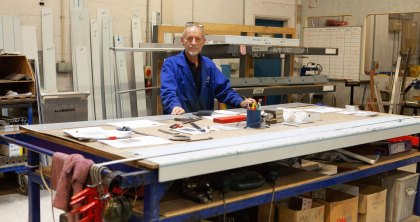Posted on June 8, 2017 in Blog
It’s easy to see why outdoor spaces are so highly desired among potential homebuyers. However, with space often at a premium, architects, designers and house builders are looking for creative ways to provide this luxury living space. This is where access box rooflights can provide an excellent solution.
Outdoor space in urban areas
Blocks of flats, skyscrapers, mixed use developments and vast swathes of pavement mean that finding greenery within the city walls can be difficult. In fact, older buildings were often constructed without any thought of providing residents with outdoor space.
As a result many existing properties are being upgraded to include roof terraces to increase the amount of available living space, and are also becoming a contemporary feature for residential developments and exclusive properties.
As part of Taylor Wimpey’s development at the St Dunstan’s House site in the City of London, the house builder sought to deliver the optimum sales value per square foot, while also maximising the amenities available. To help achieve this goal, generously sized triplexes were built on the top level of the building, which included roof terraces for that highly prized outdoor space. The terraces also offered amazing views across the capital, featuring iconic sights of the London Eye and Big Ben.
Not just for city dwellers
Roof terraces may be coveted features in metropolitan locations where private outdoor space is rare – but there’s also a growing appetite for them in more rural areas. Just like in the city, suburban and rural roof terraces are perfect spots for dining and socialising, while also providing an elevated vantage, overlooking the surrounding area.
When the water tower of the former Lancaster Moor Hospital was converted to a luxury apartment, a box rooflight was used to provide access to the roof terrace, unlocking picturesque views across the Fells of Bowland and Morecambe Bay. The completed terrace also provided a generous amount of outdoor living space, and all the work was completed in a way that maintained the Gothic building’s unique appearance.
Box rooflights provide a technical solution to the headspace required over a flight of stairs for roof terrace access, whilst creating an aesthetically pleasing feature within both urban and rural locations. They are easy to install, increase daylight exposure within the building’s interior and provide natural ventilation.

Using box rooflights to boost property value
Research from estate agents Marsh & Parsons in 2015 found that a roof terrace or balcony can add an average of 12% to the value of a property, and this can rise to as much as 25% in exclusive city locations.
While a roof terrace conversion could cost anywhere from £10,000 to £75,000 or more, depending on the size and amount of work required, the long-term financial gain is certainly worth the price. The roof terrace will quickly pay for itself by increasing the value of the property.
Access considerations for box rooflights
With so many benefits to box rooflights, there’s no doubt that a roof terrace is an excellent option for upgrading an existing property and providing outdoor space for new-build homes. However, they also require careful planning, and access is one element that must be considered from the very beginning of a project.
Part K of the Building Regulations defines what requirements must be met if you’re specifying an access rooflight; the document will be of particular interest because of its focus on stairs. It states that a minimum head clearance of 2m (measured from the pitch line) is adequate for access between levels of a building. In most situations, private stairs intended for use in only one dwelling can have a maximum permitted pitch of 42 degrees.
Part K also deals with safety around a variety of building components, in order to prevent injuries due to falls, collisions and impacts.
Here at Glazing Vision, our box rooflights can be manufactured to meet specific requirements in terms of size, glazing and openings.
Find out more about our range of box rooflights and Part K building regulations, or give us a call on 01379 658 300.














